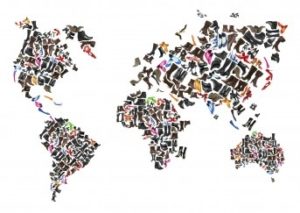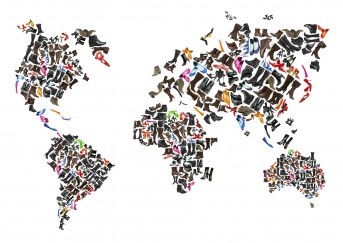It is the most surprising fact to emerge from the “2018 World Footwear Yearbook” report promoted by Portuguese Shoes: the relentless advance of fabric footwear, led by the global success of the knit sneaker. A phenomenon that continued to advance also in 2017, with a +14.9% rise in exports and +9.1% increase in average export price. At the same time, new shares were acquired above all by footwear with a leather upper, which despite only a small export recovery of +2.9% in 2017, had previously fallen by -16.7% in the previous two-year period. So, it’s no longer possible to dismiss this phenomenon as a passing trend: fabric footwear is a reality that is here to stay.
 In 2017, the World Footwear Yearbook underlines a slowdown in the growth of global footwear production (23.5 billion pairs, up +2% compared to 2016) and a repositioning of exports, which have fallen everywhere except in Europe, which however only accounts for a 13.8% share of world exports, placing it far from the unattainable share of 83.3% accounted for by Asia.
In 2017, the World Footwear Yearbook underlines a slowdown in the growth of global footwear production (23.5 billion pairs, up +2% compared to 2016) and a repositioning of exports, which have fallen everywhere except in Europe, which however only accounts for a 13.8% share of world exports, placing it far from the unattainable share of 83.3% accounted for by Asia.
The analysis of the main players in production still sees China in the lead, with India following close at its heels with a respectable +10% increase over the previous year, followed by Vietnam and Indonesia. Important performances were also registered by Turkey, which more than doubled its production in recent years (but who knows if it will be able to maintain this position in 2018 with the devaluation of the lira), and Italy, which pushed Thailand out of 10th place. Brazil instead fell back to fifth place, also because of the weak demand of its domestic market. Together, the top 10 manufacturing countries represent 88-89% of global production.
There is also a repositioning of footwear consumption that continues to move from more mature economies (North America and Europe) to younger ones, in a trend that is more in line with the distribution of the global population, which has been underway for several years and will likely continue also in the future. The world’s top ten consumer countries represent 60% of worldwide consumption: at the top of the classification is China, followed by India, which steals second place from the USA.
As far as exports are concerned, after five years of suffering losses, China saw its share grow to 67.5% in 2017. Other Asian producers experienced results to the contrary: Hong Kong continued with its downtrend and dropped out of the first ten exporters, while Vietnam, Indonesia, and India also lost shares. In contrast, many European countries gained shares, even though only Italy is an important producer in Europe, thus reconfirming the tendency to adopt a business model of re-exporting in Europe. On a continental level, intra-continental exports are reconfirmed above all in Europe and North America, while Asian exports are decidedly extra-continental.
Finally, although 8 of the leading importers are European, the USA remains the leader in the classification of top ten importers. In Asia, only Japan makes the top ten, although on a continental level, Asia and Africa are confirmed as increasingly important in a trend that will continue to grow also in the future.



